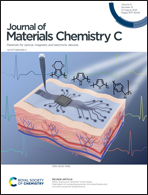Extreme modulation of liquid crystal viscoelasticity via altering the ester bond direction†
Abstract
The understanding of correlations between molecular details and macroscopic material behavior is a fundamental question of molecular chemistry/physics and offers practical interest in materials design with fine-property-tunability. Herein, we demonstrate extreme modulation of liquid crystal (LC) viscoelasticity triggered by a reversion of the ester bond direction in two series of sulfur-containing cyanobiphenyl-based LC dimers. They possess two oppositely directed ester linkages (i.e., C![[double bond, length as m-dash]](https://www.rsc.org/images/entities/char_e001.gif) OO or OC
OO or OC![[double bond, length as m-dash]](https://www.rsc.org/images/entities/char_e001.gif) O), namely COOn and OCOn, respectively, and different carbon atom numbers of the short alkylene spacers (n = 4 and 6). Unexpectedly, it has been proven that the COOn homologs exhibit extraordinarily enhanced viscoelastic properties in the fluidic nematic (N) phase (up to about 1000 times) compared with their OCOn counterparts. Besides, dielectric spectroscopy revealed that the degree of the collective orientational fluctuation is significantly affected by reversing the ester bond direction, suggesting the existence of heliconical clusters embedded in the N state. Finally, we have proposed a novel eco-driving LC memory device based on a pulse-electric-field driving method using COO4 with an extremely high rotational viscosity.
O), namely COOn and OCOn, respectively, and different carbon atom numbers of the short alkylene spacers (n = 4 and 6). Unexpectedly, it has been proven that the COOn homologs exhibit extraordinarily enhanced viscoelastic properties in the fluidic nematic (N) phase (up to about 1000 times) compared with their OCOn counterparts. Besides, dielectric spectroscopy revealed that the degree of the collective orientational fluctuation is significantly affected by reversing the ester bond direction, suggesting the existence of heliconical clusters embedded in the N state. Finally, we have proposed a novel eco-driving LC memory device based on a pulse-electric-field driving method using COO4 with an extremely high rotational viscosity.



 Please wait while we load your content...
Please wait while we load your content...